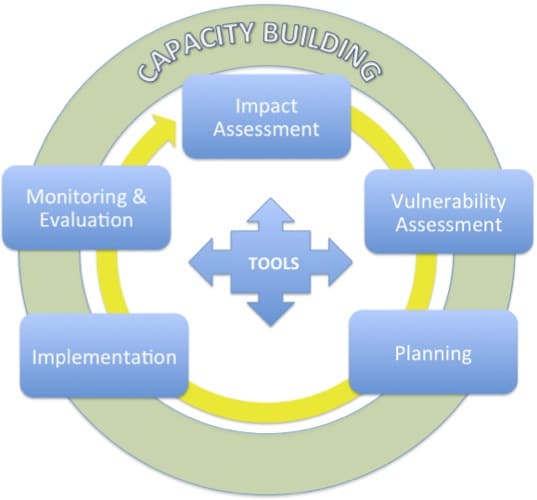A synopsis from EcoAdapt of the state of adaptation in the United States that highlights the range of activities that are currently underway, as well as opportunities for growth.
WHY YOU SHOULD TAKE A LOOK:
The report provides examples of the variety of work on climate change adaptation in the United States, the resultant gaps and possible solutions for advancing adaptation within agriculture, natural resources, human communities and policy.
KEY TAKEAWAYS:
Adaptation has moved from a theoretical concept that was often viewed as a threat to mitigation efforts, to a widely recognized mandate to reduce vulnerability to climate change.
Adaptation action opportunities:
- Implementing adaptive actions
- Building capacity for doing the work of adaptation
- Creating cross-sectoral linkages
- Monitoring and evaluation progress and outcomes
- Overcoming uncertainty
- Funding: using what we already have and getting more where needed
- Advertising adaptation to increase action
Recommendations for moving adaptation forward:
- A national adaptation forum
- Adaptation help desk
- American Society of Adaptation Professionals
- Taking stock of existing guidance
- Climate change adaptation communication
- Kick-start adaptation implementation
- Identify Pathways for Success
- Move the climate change agenda beyond its current perception as being an environmental issue
Most people don't know what adaptation is. There is a need to develop framing and messaging for the public and policymakers about adaptation, why it’s necessary and what it entails.
Adaptation needs to be understandable, approachable and embraceable
The adaptation process can be thought of as a cycle that includes: impact assessment, vulnerability assessment, planning, implementation, and monitoring and evaluation. Most efforts to date have focused on impact assessment, with the least amount of focus on monitoring and evaluation of adaptation efficacy.


Adaptation success will be more likely by building solutions across sectors, which will require more multi-stakeholder and multi-sectoral processes and approaches.
Most people are unaware that they can engage in adaptation and that it is essential for positive outcomes. Awareness raising approaches or adaptation “advertising” can entice people to “step on the adaptation ladder of engagement.”
Most adaptation communication analyses and products focus on individual behavior change, with less focus on how to communicate about climate risks.
The focus of a new phase of adaptation work should be on promoting successful implementation, which will require supporting leaders at all levels of government.
Funders could support leading communities and those who serve them in developing replicable models and methods to disseminate lessons learned and build networks to connect adaptation efforts across the country.
One of the greatest challenges to adaptation is that it is a new idea and most people do not know how to incorporate it into what they do. This has resulted in tremendous needs for education and training.



